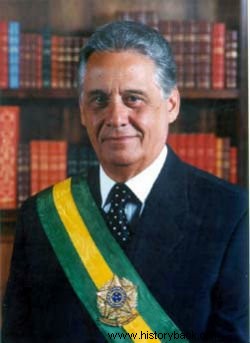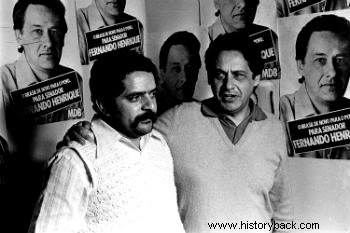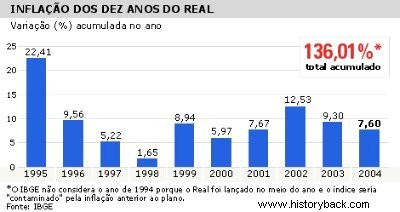Fernando Henrique Cardoso (1931- ) is a Brazilian sociologist, university professor, politician and writer. He was Minister of Foreign Affairs and Minister of Finance.
He was president of Brazil for two terms, from 1995 to 2002. He consolidated the Real Plan, established constitutional reforms, privatized state-owned companies, instituting neoliberalism in the country.
FHC Biography
Fernando Henrique Cardoso was born in Rio de Janeiro on June 18, 1931. As his father was a soldier, in 1934 he moved with his family to São Paulo. In 1952 he graduated in Social Sciences at the University of São Paulo (USP).
In 1953 he married the anthropologist Ruth Cardoso and together they had three children. That same year he specialized in Sociology, becoming a doctor in 1961.
Before graduating, he was a professor at the Faculty of Economics at USP, thanks to the sociologist Florestan Fernandes, of whom he would become the first assistant in 1955.

In addition, he was also an assistant to Professor Roger Baptiste and a teaching analyst in the chair of Sociology, at the Faculty of Philosophy at USP, in 1953.
In 1954 he was elected alumni representative, becoming the youngest member of USP's University Council.
In 1960, he joined the direction of the Center for Industrial and Work Sociology (Cesit), founded at USP. He studied postgraduate studies at the Laboratoire de Sociologie Industrielle from the University of Paris in 1962 and 1963.
In 1964, with the Military Coup, Fernando Henrique, accused of subversion, was forced to go into exile, remaining three years in Chile.
There, he worked at the Economic Commission for Latin America and the Caribbean (ECLAC) and the Latin American Institute for Economic and Social Planning (ILPES). He taught at the Latin American Faculty of Social Sciences (Flacso) and at the University of Chile.
He was invited to teach in France and moved in 1967 to Paris, where he taught at the University of Paris-Nanterre. In 1968, back in Brazil, he conquered the chair of Political Science at USP, returning to his academic career.
With the AI-5 he would be compulsorily retired as a university professor at age 37. He founded the Cebrap (Brazilian Center for Analysis and Planning) which would become a source of intellectual resistance to the military regime. Likewise, he teaches at several foreign universities as he was prevented from doing so in Brazil.
In 1974, opposition leader Ulysses Guimarães sought him out to prepare the MDB's program for the elections and later, Fernando Henrique himself would run for political office.
See also:Military Dictatorship in Brazil (1964-1985)Political Career
In 1978, Fernando Henrique Cardoso becomes Franco Montoro's substitute for the Senate, for the MDB, with 1 million votes.
In 1983, with the election of Franco Montoro to the government of São Paulo, Fernando Henrique took over as Senator. That same year, he becomes the articulator of the campaign for “Diretas já”.

In 1985 he loses the elections for mayor of São Paulo to Jânio Quadros. In 1986 he was re-elected to the Senate and that same year he founded the Brazilian Social Democratic Party (PSDB).
The new party brought in members of the PMDB who were more akin to the positions of the center, who were critical of President José Sarney and no longer identified with this party. In 1988 he was a member of the National Assembly that drafted the Constitution.
In 1992, in the government of Itamar Franco, he occupied the portfolio of Foreign Affairs and a year later was appointed Minister of Finance.
Real Plan
His main task in this Ministry was to contain inflation and reorganize the economy. With a group of economists he worked out a gradual stabilization plan.
In March 1994, the Real Value Unit (URV) was created. This was an index that would correct prices, wages and services daily, as if it were a kind of currency.
On July 1st, a new currency was introduced, the real, with the value of one URV, equivalent to 2,750 cruzeiros, a currency that disappeared. With the introduction of the real, inflation dropped to minimum levels.
Fernando Henrique became a natural candidate for the government parties in the presidential elections. Basing his campaign on the success of the Plano Real, he won the elections in the first round. The new president took office on January 1, 1995.
First Term (1994-1998)
In addition to the Real Plan, the aspect of the government's program was a series of constitutional reforms, considered essential to modernize the country and guarantee economic stability.
His government was marked by the breaking of the state monopoly of oil, telecommunications and electricity and the privatization of state-owned companies.
Several difficulties arose and added to the consequences of the Asian crisis and the Russian crisis. The government's exit was to resort to loans and technical advice from the IMF.

State Reform and Privatizations
The Fernando Henrique government was marked by the reform of the civil service and privatizations.
In order to obtain a reduction in state expenditures, FHC managed to end - in part - with the stability of the public service. Thus, state governments were forced to reduce the number of employees in their agencies.
Likewise, it released the contracting of outsourced services by public and private companies, ending stable employment.
As for privatizations, they affected both state and federal companies. Banks, electricity, railways and telephone companies were privatized during the eight years of FHC's government.

Second Term (1998-2002)
In order to gain support for his reelection, in 1998, the PSDB sent a bill to Congress that guaranteed reelection to executive positions.
The law was approved and, in the midst of an economic crisis, the October 1998 elections took place. With the success of fighting inflation, Fernando Henrique was reelected.
However, with unemployment and inflation threatening Brazil again, the government makes new agreements with the IMF (International Monetary Fund).
This requires controlling public spending and increasing production as a condition for new loans. This leads to the creation of the Fiscal Responsibility Law for states and municipalities
Despite the various external crises that impacted the Brazilian economy during the four years of the second government and thanks to the continuity of the Real Plan, inflation remained low.
Even so, historical problems such as poor income distribution, social inequality and precariousness in health and education have not been resolved.
For this reason, in 2002, it failed to make the PSDB candidate, José Serra, win the elections, which were won by Luiz Inácio Lula da Silva that year.
After the Presidency
After the end of his term, Fernando Henrique Cardoso did not run for any political office, but he remains active giving interviews, publishing books and participating in debates on the Brazilian political situation. He became one of the dissonant voices of the Lula government, criticizing some decisions of his government.
In order to preserve the legacy of his government, he created the Instituto Fernando Henrique Cardoso in São Paulo, open to anyone interested in knowing more about this period of Brazilian history.
In 2008, his wife Ruth Cardoso passed away, which meant a great loss for the former president. A few years later, in 2014, he would have a stable union with a former employee of his Institute, Patricia Kundrát.
In 2013, he took office as an academic at the Brazilian Academy of Letters, occupying chair nº 36 and, in 2017, he launched the first of a series of books called "Diaries of the Presidency" that will address his stay as President of the Republic.
FHC's works
- Blacks in Florianópolis:social and economic relations, 1955
- Capitalism and Slavery in Southern Brazil, 1962
- Social Changes in Latin America, 1969
- Dependency and Development in Latin America (with Enzo Faletto), 1970
- Politics and Development in Dependent Societies, 1971
- Industrial Entrepreneur and Economic Development in Brazil, 1972
- The Brazilian political model:and other essays, 1973
- Authoritarianism and Democratization, 1975
- Ideas and their place:essays on development theories, 1980
- Building Democracy:Studies in Politics, 1993
- Get to work, Brazil:government proposal, 1994
- For a fairer Brazil:government social action, 1996
- National Defense Policy, 1996
- Sustainable development, social change and employment, 1997
- Advance Brazil:4 more years of development for all:government proposal, 1998
- The other face of the president:speeches by senator Fernando Henrique Cardoso, 2000
- Brazil 500 years:future, present, past, 2000
- The Art of Politics, 2006
- Letters to a Young Politician, 2006
- Cultura das Transgressões no Brasil, 2008
- Globalized Brazil, 2008
- Latin America:Governance, globalization and economic policies beyond the crisis, 2009
- Remembering What I Wrote, 2010
- International Chess and Social Democracy, 2010
- The Sum and the Rest, 2011
- The Unlikely President of Brazil, 2013
- Thinkers who Invented Brazil, 2013
- The Misery of Politics, 2015
- Presidency Diaries - 1995-1996, 2015
Read more: What is Sociology?
